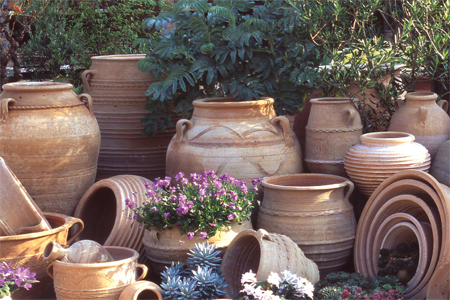
Spring is in the air...
Issue 4 Mar / Apr 2004
Get out the rakes and trowels…the annual spring planting ritual is upon us! All over Britain cash registers will be ringing up sales as gardeners attempt to revive their gardens. Gardening is after all one of the season’s favourite pastimes. With Spring just around the corner Angelique Franke finds it is time to get serious.
The best way to succeed in gardening is to plan ahead and do the various jobs at the right time. Allocating a realistic amount of time each week to your garden should become a routine task and will be far more efficient in the long run. Take the time to look around and get to know your garden as that way you’ll keep on top of any problems.
However with the fickle weather and the vast amount of different types of plants its easy to get confused about when to do what. Therefore what better place to go for advice than Kew Gardens, one of the world’s most famous botanic gardens, housing a collection of plants from around the world.
Richard Wilford is Manager of the Hardy Display Section and the Horticultural and Public Education Department of Kew Gardens. He has a few invaluable tips to spare. “Get outdoors and prepare for spring. The work you do now will be the most rewarding and will make your garden so much nicer in summer. Early spring is the best time for mulching. If you have garden compost heap, now is the time to use it as the plants are dormant and therefore good to work with as you can easily get to the soil.
Using compost maintains the moisture and keeps the weeds down. Ideally you should cover the soil with 3- 4 inches of compost, which happily lets the plants grow through, but any thinner will allow the weeds to come through again. If you have no compost then a good idea is to liquid feed your plants instead. An organic dust called bone meal is highly effective when sprinkled over the soil. Doing this in early spring means the plants have food ready for when the weather turns warmer. Early spring is also the ideal time to clean away any leaves so make sure you tidy your garden. This is also a perfect opportunity to cut your plants back. If you have roses you should not leave the pruning too late or they will grow too big so cut them back to encourage new growth in the spring. Your soil also needs air and any neglected areas should be dug over as soon as possible to open up the soil.”
Healthy soil is the basis for healthy grass, plants and flowers. Good soil will allow the water, air, nutrients and roots to travel through it with ease. A soil moisture meter can help you measure how damp your soil actually is.
If your soil is too wet or too dry it will get damaged. A good test to see if your soil has the correct moisture in it is to grab a handful and squeeze. Your soil should be able to make a ball without falling apart. If it’s too dry then give it a good watering.
Its always best to plant seeds in rows rather than scattering them. Then you can hoe between the rows and as soon as the seedlings start to come up you can mulch around them. Hardy plants are the best to plant around this time as they can withstand different types of weather and will come back year after year. Some examples of plants that are good to plant at this time of the year are: Peonies, Roses, Aquilegias, Delphiniums, Phlox Grammy, Columbines, Impatiens, Penstemons, Marigolds, Thunbergias and hardy Geraniums. These will give colour to your garden year after year.
For your summer bedding such as Salvia and Zinnia you should wait until after May when the weather has become stable. Winter bedding such as Pansies and Perennial Wallflowers can be planted throughout the winter. Wallflowers will remain colourful all year round if you are lucky.
For instant spring, it is hard to beat pots of stoutstemmed, tight-budded tulips, daffodils and other spring flowers. Whether planning to display the flowers inside the home or outdoors, buy potted spring bulb flowers when at a young stage with buds formed but not yet fully emerged. Watching the plants grow and mature can provide weeks of enjoyment, culminating in full bloom.
Bulbs are generally offered in plastic or terra cotta pots. They can be dressed up by repotting or double potting in a decorative container. To repot, gently tap out the nursery pot contents (keeping bulbs and soil intact to avoid root damage). Repot in a more decorative container with a drainage hole and saucer for collecting water.
To double-pot, just lower the potted plant (still in its nursery pot) into the desired container that is just slightly larger. You can use a pretty container with no drainage hole (often called a cachepot) or a pot with a drainage hole and saucer.
Add water to keep the soil moist but not soggy. The best technique is to put the pot in the sink, water well so water pools inside the pot rim, then let water drain out the bottom of the pot.
Spring Bedding Plants
Bedding plants are either once-flowering annual plants or, like wallflowers, they are perennials but treated as annuals. Bedding plants can be used in traditional flower beds, or in the more modern way as fillers and in pots and containers. Usually planted in late March or early April, no other group brings such exuberant colour. They have two peak periods – springtime for over-wintered bedding plants and summer for the main display. Bedding plants require direct sunlight or very good artificial light to do well.
Because bedding plants grow quickly, the soil in the small pots soon loses its nutrients. To provide strong, continuous growth, fertilize the bedding plants weekly. n Harden-off the bedding plants by gradually reducing fertilizer and water before you plant them outside. You can also gradually expose the bedding plants to bright sun, wind and cold nights before planting outside. These practices will help to acclimatise the plants so that they will not be shocked when exposed to outside conditions. Give the plants enough water so that they do not wilt severely before planting outside.
Top tips for preparing your garden for spring
- Start preparing your garden early
- The sooner you start weeding the easier the job will be in summer
- Feed plants for spring
- Keep your garden tidy
- Look after neglected areas and dig over the soil
Useful websites
www.insideoutgardening.co.uk/gardening/articles/spring.html
www.godricbj.plus.com/greenroots/gentle02.html
www.bhg.com/bhg/gardening/index.jhtml
www.thegardenhelper.com/march.html
And if you are feeling really adventurous you can do a home study course from the Institute of Gardening and receive a diploma in Horticulture. The beginner’s course teaches you to: “make the most of your garden”. Go to www.inst.org/garden to get a prospectus.
Bookmark this |
|
Add to DIGG |
|
Add to del.icio.us |
|
Stumble this |
|
Share on Facebook |
|
Share this |
|
Send to a Friend |
|
Link to this |
|
Printer Friendly |
|
Print in plain text |
|


Comments
0 Comments